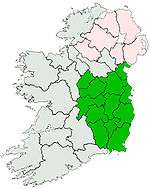Montpelier Hill
Mount Pelier Hill (Irish: Cnoc Mount Pelier)[2] is a 383-metre (1,257-foot) hill in County Dublin, Ireland.[1] It is commonly referred to as the Hell Fire Club (Irish: Club Thine Ifreann),[3] the popular name given to the ruined building at the summit believed to be one of the first Freemason lodge's in Ireland. This building – a hunting lodge built in around 1725 by William Conolly – was originally called Mount Pelier and since its construction the hill has also gone by the same name.[4] The building and hill were respectively known locally as 'The Brass Castle'[5] and 'Bevan's Hill'[6], but the original Irish name of the hill is no longer known although the historian and archaeologist Patrick Healy has suggested that the hill is the place known as Suide Uí Ceallaig or Suidi Celi in the Crede Mihi, the twelfth century diocesan register book of the Archbishops of Dublin.[7]
| Mount Pelier Hill | |
|---|---|
| Hell Fire Club | |
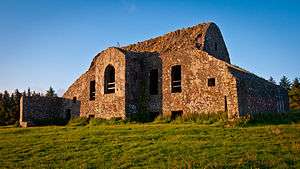 Dawn at the Hell Fire Club on Mount Pelier Hill, Dublin | |
| Highest point | |
| Elevation | 383 m (1,257 ft) [1] |
| Coordinates | 53°15′6.7″N 6°19′49.24″W [1] |
| Geography | |
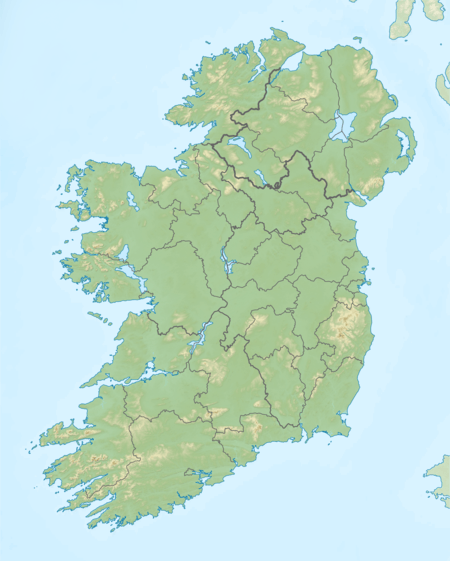 Mount Pelier Hill Location in Ireland | |
| Location | County Dublin, Ireland |
| Parent range | Dublin Mountains |
| OSI/OSNI grid | O120238 |
| Topo map | OSI Discovery No. 50 |
Mount Pelier is the closest to Dublin city of the group of mountains – along with Killakee, Featherbed Bog, Kippure, Seefingan, Corrig, Seahan, Ballymorefinn, Carrigeenoura and Slievenabawnogue – that form the ridge that bounds the Glenasmole valley.[8] On the slopes is a forestry plantation, known as Hell Fire Wood, which consists of Sitka spruce, larch and beech.[9]
Originally there was a cairn with a prehistoric passage grave on the summit. Stones from the cairn were taken and used in the construction of Mount Pelier lodge. Shortly after completion, a storm blew the roof off. Local superstition attributed this incident to the work of the Devil, a punishment for interfering with the cairn. Mount Pelier Hill has since become associated with numerous paranormal events.
Members of the Irish Hell Fire Club, which was active in the years 1735 to 1741, used Mount Pelier lodge as a meeting place. Stories of wild behaviour and debauchery and occult practices and demonic manifestations have become part of the local lore over the years. The original name of the lodge has been displaced and the building is generally known as the Hell Fire Club. When the lodge was damaged by fire, the members of the Hell Fire Club relocated down the hill to the nearby Stewards House for a brief period. This building also has a reputation for being haunted, most notably by a massive black cat.
Adjacent to the Stewards House are the remains of Killakee Estate. A large Victorian house was built here in the early nineteenth century by Luke White. White's son, Samuel, oversaw the development of extensive formal gardens on the estate, including the construction of several glasshouses by Richard Turner. The estate passed to the Massy family through inheritance in 1880 and John Thomas Massy, the 6th Baron made extensive use of the house and ground to host shooting parties and society gatherings. The fortunes of the Massy family declined in the early twentieth century and Hamon Massy, the 8th Baron, was evicted from Killakee House in 1924. He became known as the "Penniless Peer". Following the eviction, Killakee House was demolished and the gardens fell into ruin.
Today Mount Pelier Hill and much of the surrounding lands, including Killakee Estate (now called Lord Massy's Estate) are owned by the State forestry company Coillte and are open to the public.
History
The Hell Fire Club on Mount Pelier Hill
William Conolly's Hunting Lodge
The building now known as the Hell Fire Club was built around 1725 as a hunting lodge by William Conolly, the Speaker of the Irish House of Commons.[10] It was named Mount Pelier by Conolly but over the years has also been known as "The Haunted House",[11] "The Shooting Lodge",[11] "The Kennel",[12] and "Conolly's Folly".[12] It was one of several exclusive establishments using the name Hellfire Club that existed in Britain and Ireland in the 18th century.
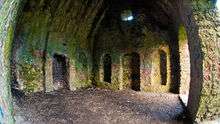
While the building has a rough appearance today, the architecture is of a Palladian design. The upper floor consists of a hall and two reception rooms. On the eastern side, there was a third, timber-floored, level where the sleeping quarters were located.[13] On the ground floor is a kitchen, servants' quarters and stairs to the upper floors. The entrance, which is on the upper floor, was reached by a long flight of stairs which is now missing.[14] At each side of the building is a room with a lean-to roof which may have been used to stable horses.[15] A stone mounting block to assist people onto their horses can be seen on the eastern side.[13] To the front there was a semi-circular courtyard, enclosed by a low stone wall and entered by a gate.[16] The house faces to the north, looking over Dublin and the plains of Meath and Kildare,[4] including Conolly's primary residence at Castletown House in Celbridge.[17] The grounds around the lodge consisted of a 1,000-acre (4.0 km2; 1.6 sq mi) deer park.[14] The identity of the architect is unknown: the author Michael Fewer has suggested it may have been Edward Lovett Pearce (1699–1733) who was employed by Conolly to carry out works at Castletown in 1724.[18]
There was a prehistoric burial site at the summit of Mount Pelier Hill and stones from it were used in the construction of the lodge.[11] A nearby standing stone was also used for the lintel over the fireplace.[19] Shortly after its completion, a great storm blew the original slate roof off. Local superstition held that this was the work of the Devil, an act of revenge for disturbing the ancient cairn.[20] Conolly had the roof replaced with an arched stone roof constructed in a similar fashion to that of a bridge.[16] This roof has remained intact to the present day, even though the building has been abandoned for over two centuries and despite the roof being set alight with tar barrels during the visit of Queen Victoria to Ireland in 1849.[20][21] There is little evidence that the lodge was put to much use. Conolly himself died in 1729.
The Hell Fire Club
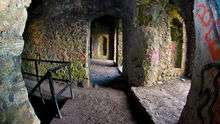
The Irish Hell Fire Club was founded around 1737 by Richard Parsons, 1st Earl of Rosse, and James Worsdale.[22] Lord Rosse was probably the president of the club.[23] Evidence of the identities of other members comes from a painting by Worsdale entitled The Hell Fire Club, Dublin, now held by the National Gallery of Ireland, which shows five members of the club seated around a table.[24] The five men are Henry, 4th Baron Barry of Santry (who was tried and convicted for murder in 1739);[25] Simon Luttrell, Lord Irnham; Colonel Henry Ponsonby; Colonel Richard St George and Colonel Clements.[24] Most of their meetings occurred in Dublin city centre at the Eagle Tavern on Cork Hill, near Dublin Castle.[26] Accounts of the club's meetings claim that members drank "scaltheen", a mixture of whiskey and hot butter, and that they left a chair vacant at each gathering for the Devil.[27] The club's mascot was a black cat.[27]
The Hell Fire Club rents the Connolly Hunting Lodge
At some stage the lodge at Mount Pelier was let to the club by the Conolly family (coincidentally, William Conolly had purchased Mount Pelier Hill from Philip, Duke of Wharton, founder of the first Hell Fire Club in 1719.[28]).[29]
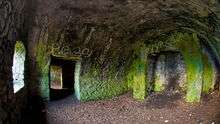
It is not clear to what extent, if any, the Hell Fire Club made use of the building. The author Michael Fewer has suggested that the remoteness of Mount Pelier's location is why there are almost no verifiable accounts of the activities that went on there.[30] However, numerous (and very doubtful) stories surrounding the building have become part of local folklore, some of which have spread to a wider audience through publication in the nineteenth century in books such as Robert Chambers' Book of Days (1864) and in The Gentleman's Magazine (1731–1922).[27]
One of the best known of these tells of a stranger who arrived at the club on a stormy night. Invited in, he joined the members in a card game. One player dropped his card on the floor and when he bent under the table to retrieve it noticed that the stranger had a cloven hoof. At this point the visitor disappeared in a ball of flame. This story, which is found in texts from at least the 1930s, is very similar to one associated with Loftus Hall, County Wexford.[31] The Loftus family owned a hunting lodge – known as Dolly Mount – which was also to be found on Mount Pelier Hill.[32]
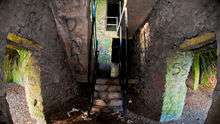
Another story tells of a priest who came to the house one night and found the members engaged in the sacrifice of a black cat. The priest grabbed the cat and uttered an exorcism upon which a demon was released from the corpse of the cat.[33]
One tale centres on club member Simon Luttrell, Lord Irnham, later Earl of Carhampton, one time Sheriff of Dublin.[33] Luttrell is believed to have been the subject of The Diaboliad, a 1777 poem dedicated to "the worst man in England".[34] According to the story, Luttrell made a pact with the Devil to give up his soul within seven years in return for settling his debts but, when the Devil came to Mount Pelier lodge to claim his prize, Luttrell distracted the Devil and fled.[34]
Other tales recount numerous drinking sessions and black masses at which animal sacrifices, and on one occasion the sacrifice of a dwarf, took place.[33]
At some point during this period, the building was damaged by fire. There are several stories connected with this incident. One holds that the club set fire to the building when William Conolly's son refused to renew the lease on the lodge.[29] An alternative story claims the club members did it to give the building a hellish appearance.[35] Another story recounts that, following a black mass, a footman spilled a drink on "Burn-Chapel" Whaley's coat. Whaley retaliated by pouring brandy over the man and setting him alight. The fire spread around the building and killed many members.[36] Following the fire, the club relocated further down the hill to Killakee Stewards House.[37] However, the club's activities declined after this incident.[38]
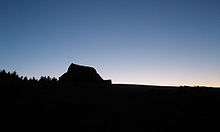
The Irish Hell Fire Club was revived in 1771 and was active for a further 30 years.[39] Its most notorious member was Thomas "Buck" Whaley, son of Richard Chappell Whaley.[39] This new incarnation was known as "The Holy Fathers".[39] Meetings once again took place at Mount Pelier lodge and, according to one story, the members kidnapped, murdered and ate a farmer's daughter.[38] Whaley eventually repented and, when he died in 1800, the Irish Hell Fire Club disbanded with his death.[38]
After the Hell Fire Club
The antiquarian Austin Cooper visited the house in 1779 and found it in a state of disrepair.[40] Joseph Holt, a general of the Society of the United Irishmen recorded in his memoirs that he spent a night in the ruin of Mount Pelier while on the run following the 1798 Rebellion.[7] Holt wrote of his experience, "I lay down in the arched room of that remarkable building. I felt confident of the protection of the Almighty that the name of enchantment and the idle stories that were told of the place had but a slight hold of my mind."[30] The Conollys sold the lands to Luke White in 1800.[41] They passed through inheritance to the Massy family of Duntrileage, County Limerick.[42] When the Massy family became bankrupt, the lands were acquired by the State.[42] Today, the building is maintained by Coillte, who manage the forestry plantations on Mount Pelier's slopes, and have installed concrete stairs and iron safety rails across the upper windows.[43]
Prehistoric monuments
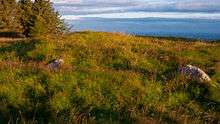
The remains of the prehistoric monument that originally stood at the summit can be seen to the rear of the Hell Fire Club building. Austin Cooper, on his visit in 1779, described it thus: "behind the house are still the remains of the cairn, the limits of which were composed of large stones set edgeways which made a sort of wall or boundary about 18 inches (46 centimetres) high and withinside these were the small stones heaped up. It is 34 yards (31 metres) diameter or 102 yards (93 metres) in circumference. In the very centre is a large stone 9 feet (2.7 metres) long and 6 feet (1.8 metres) broad and about 3 feet (0.91 metres) thick not raised upon large stones but lying low with the stones cleared away from about it. There are several other large stones lying upon the heap."[44] It appears from this description that the central chamber of the monument – which was a passage grave[19] – survived intact even after Mount Pelier was constructed.[40] The historian Peter J. O'Keefe has suggested that many of the stones were taken away and used in the construction of the Military Road at the start of the nineteenth century.[13] Today, all that remains is a circular mound 15 metres (49 feet) in diameter and up to 2 metres (6.6 feet) high with a dip at the centre where the chamber was located.[19] The four large stones at the edge are all that survive of the kerbstones that formed the boundary of the monument.[45] In close proximity is a second mound, 1 metre (3.3 feet) high, on which an Ordnance Survey trig pillar stands.[19] Close to the monument is a fallen standing stone, a pointed rock 1 metre (3.3 feet) high.[46]
However, in October 2016 a further excavation discovered a huge passage grave similar to that at Newgrange, probably dating back 5,000 years, under the ruins.[47]
The Stewards House
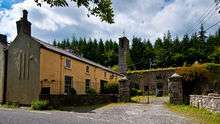
Further down the hill, along the Military Road, is a two-story house, known as The Stewards House or as Killakee House (not to be confused with the now-demolished Killakee House that served as the residence of the Massy family who owned the adjacent Killakee Estate). It was built around 1765 by the Conolly family as a hunting lodge.[48] Over the years, it has served as a dower house and as a residence for the agent who managed the Killakee Estate.[49] To the rear is a belfry; this was once a common feature of large farmhouses and was used to call the workers for meals.[49] The Hell Fire Club held meetings here for a time following the fire that damaged Mount Pelier lodge.[37] The house has a reputation for being haunted, particularly by a large black cat.[50] Stories regarding the origin of this spectre either connect it with the account of the priest who exorcised a cat at the Hell Fire Club[51] or with a cat that was doused in whiskey and set alight by members of the Hell Fire Club before escaping across the mountains with its fur aflame.[52]
The best documented account of these hauntings occurred between 1968 and 1970. The Evening Herald and Evening Press newspapers carried a number of reports regarding a Mrs Margaret O'Brien and her husband Nicholas, a retired Garda superintendent, who were converting the house into an arts centre.[33] The redevelopment had been a troubled affair with tradesmen employed on the work leaving complaining of ghosts.[53] One night, a friend of the O'Brien's, artist Tom McAssey, and two workmen were confronted by a spectral figure and a black cat with glowing red eyes.[54] McAssey painted a portrait of the cat which hung in the house for several years after.[54] Although locals were sceptical of the reports,[54] further apparitions were reported, most notably of an Indian gentleman and of two nuns called Blessed Margaret and Holy Mary who had taken part in black masses on Mount Pelier Hill.[51] There were also reports of ringing bells and poltergeist activity.[54] In 1970 an RTÉ television crew recorded a documentary at the house.[55] In the documentary a clairvoyant called Sheila St. Clair communicated with the spirits of the house through automatic writing.[56] In 1971, a plumber working in the house discovered a grave with a skeleton of a small figure, most likely that of a child or, perhaps, the body of the dwarf alleged to have been sacrificed by the members of the Hell Fire Club.[54] The house operated as a restaurant in the 1990s before closing in 2001; it is now a private residence.[50]
Killakee (Lord Massy's) Estate
On the other side of the Military Road to Hell Fire Wood and the Stewards House is the remains of Killakee Estate (Irish: Coill an Chaoich, meaning "Blind Man's Wood"),[57] now known as Lord Massy's Estate.[58] These lands were first granted to Walter de Ridleford after the Norman invasion and later given to Sir Thomas Luttrell, an ancestor of Hell Fire Club member Simon Luttrell, by Henry VIII.[42] The Luttrell family held onto the estate until the seventeenth century when it was relinquished to Dudley Loftus and then passed to William Conolly.[42] In 1800, the Conolly family sold the estate to Luke White.[41]
.jpg)
The White family built Killakee House on the estate in the early nineteenth century.[59] This was a two-storey, thirty-six roomed stucco-faced house.[60] It had a Tuscan-columned entrance and large three-windowed bows on the back and sides.[59] Luke White's second son, Colonel Samuel White, inherited the estate on his father's death in 1824 and invested considerable effort in developing its gardens.[61] In 1838, he engaged the services of Sir Ninian Niven, former director of the Botanic Gardens in Dublin.[62] Niven laid out two Victorian formal gardens of gravel walks, terraces and exotic trees decorated with statues of Greek and Roman gods.[62] Adjacent to the house was a terraced rose garden with a statue of Neptune.[62] A second walled garden in a vale in the woods below the house contained more fountains and a range of glasshouses designed by Richard Turner.[61] William Robinson, writing in The Gardener's Chronicle and Agricultural Gazette on 10 December 1864, said of the gardens, "I know of no better example of the advantage of extensively planting and draining a barren and elevated district than is afforded by this demesne of 500 acres."[63]
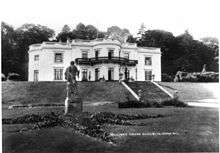
When Samuel White's widow, Anne, died in 1880, she bequeathed the estate to her late husband's nephew, John Thomas, 6th Baron Massy.[64] The Massys were a Protestant Ascendancy family who had come to Ireland in 1641 and owned extensive lands in Counties Limerick, Leitrim and Tipperary.[65] Massy used Killakee House to entertain guests while shooting game on nearby Cruagh and Glendoo mountains.[66] He also used the house to host parties during major events on the Dublin social calendar such as the Dublin Horse Show, the Punchestown Races and the Dublin Castle Season.[67] During these events long lines of guests' carriages could be seen stretched along the road leading to the house.[68] However, as a result of declining rental income and poor investment decisions, John Thomas Massy was in considerable debt when he died in 1915.[66] By the time John Massy's grandson, Hugh Hamon Charles, 8th Baron Massy, inherited the estate, the family's finances were in an irreversible decline and in 1924 he was declared bankrupt and evicted from Killakee House.[69] The Massys initially moved into the Stewards House before taking up residence in Beehive Cottage, the estate's gate lodge, by agreement with the bank.[70] Hamon Massy, unable to find a job on account of his alcoholism became dependent on his wife, Margaret, whose modest salary from a job with the Irish Hospitals' Sweepstake was the family's only income.[71] In the years up to his death in 1958, Hamon Massy, who became known as the "Penniless Peer", could be seen collecting firewood in the woods of his former family estate.[72]
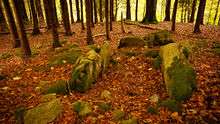
Following the eviction, Killakee House was briefly used as an operations base by the Detective Unit of the Garda Síochána in 1931 while they hunted IRA subversives who were hiding explosives at Killakee.[73] When the bank was unable to find a buyer for the estate, it was acquired by a builder who stripped the house and then demolished it in 1941.[66] The lands were eventually acquired by the State and opened to the public.[74] In the late 1930s, the Director of Forestry, a German called Otto Reinhard, laid out the area as an urban forest.[9] The trees have reclaimed most of the land once occupied by the formal gardens: all that remains is the brickwork at the rear of the Turner glasshouses and the system of irrigation canals and ponds for the exotic plants contained within.[75]
In 1978, the archaeologist and historian Patrick Healy discovered the remains of a prehistoric wedge tomb in the woods.[45] All the survives is the skeletal outline of the main chamber and the outer double walls.[76] Most of the stones were removed to build the low stone wall that runs across the front of the tomb.[77]
Carthy's Castle
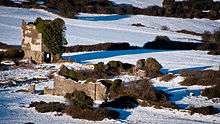
On the northern slopes is another ruined building, known as Carthy's or McCarthy's Castle.[78] This is all that remains of Dolly Mount – also known as the "Long House" and "Mount Pelier House" – a large hunting residence built by Henry Loftus, Earl of Ely towards the end of the eighteenth century.[32] The building was originally two stories high with bow windows each side of the hall door, above which was the Ely coat of arms.[79] At each side of the house was an arched gate from which extended a range of ancillary buildings, terminating in a three-storied tower with an embattled top and pointed windows.[80] The interiors were noted for their marble chimney pieces and stuccoed ceilings.[80] The earl's first wife, Frances Monroe, was the aunt of Dorothea "Dolly" Monroe who was a celebrated beauty and in whose honour the house was named Dolly Mount.[81] The Ely's subsequently abandoned the residence and the building soon fell into ruin, mainly at the hands of a tenant called Jack Kelly who wrecked the house to ensure his tenancy would not be disturbed.[82] All, except for the tower at the western end, which is now known as Carthy's Castle, was demolished in 1950.[83]
Orlagh House
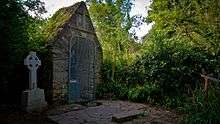
In the land adjacent to Carthy's Castle is Orlagh House which has been owned by the Augustinian Order since the mid-nineteenth century and is a retreat and conference centre run by the friars.[84] It was built in 1790 by Mr Lundy Foot, a wealthy snuff merchant, who named the house Footmount.[84] He was also a magistrate and was instrumental in condemning three members of the Kearney family to death for the murder of John Kinlan, the gamekeeper at Friarstown, near Bohernabreena, in 1816.[85] Foot was subsequently murdered in 1835, an act that was attributed to relatives of the Kearneys.[86] In fact, Foot was killed by James Murphy, the son of an evicted tenant farmer whose land Foot had bought following the eviction.[87]
In 2017, Orlagh House was sold to a private buyer. With the decline in the Church, it was no longer economic for the small group of elderly Augustinians to live in such a large residence.
In a field opposite Orlagh House is a holy well associated with Saint Colmcille. A statue of the saint, designed by Joseph Tierney, was erected at the site in 1917.[88] Pilgrims either drink the water or apply it to sore ears.[89]
Access and recreation
Mount Pelier Hill is accessed from the Hell Fire Wood car park along the R115 road between Rathfarnham and Glencullen.[9] The woods consist of around 4.5 kilometres (2.8 miles) of forest roads and tracks.[9] Lord Massy's Estate is also accessed from the R115, close to the Hell Fire Wood car park.[58] The woods offer a nature trail and a permanent orienteering course.[58] Lord Massy's Estate and Mount Pelier Hill are also traversed by the Dublin Mountains Way hiking trail that runs between Shankill and Tallaght.[1]
Development Plans
In March 2017 plans were announced by South Dublin County Council, Coillte and the Dublin Mountains Partnership for a major Dublin Mountains Project development on the site of Mount Pelier Hill and the Hellfire Club, involving parking, a cafe, a treetop walkway, improved trails and a Visitors Centre.
Local residents and community groups have expressed opposition to the plan, citing the delicate eco-system of the area, risks of damage to recently discovered megalithic artwork and fears of traffic congestion resulting from a possible 300,000 visitors to the site.[90] These groups have launched a campaign entitled "Save the Hellfire" aimed at persuading An Bord Pleanála to refuse planning permission for the project.
See also

References
Notes
- Discovery Series No. 50 (Map). Ordnance Survey Ireland.
- Cnoc Mount Pelier Placenames Database of Ireland. Retrieved: 2014-08-30.
- "Hell Fire Club". Irish Placenames Database. Department of Culture, Heritage and the Gaeltacht. Retrieved 6 June 2020.
- Joyce, p. 125.
- "The Hell Fire Club". dúchas.ie.
- 'The Angling Excursions of Gregory Greendrake' by Henry Brereton Cody - p. 122
- Healy, p. 47.
- Healy, p. 36.
- "Hell Fire Club". Coillte Outdoors. Retrieved 1 August 2010.
- Handcock, p. 86-87.
- Joyce, p. 123.
- Handcock, p. 86.
- Fewer, p. 70.
- Handcock, p. 87.
- Healy, p. 44.
- Joyce, p. 124.
- Ball, p. 40.
- Fewer, Michael (May–June 2010). "Gems of Architecture: The Hellfire Club, Co. Dublin". History Ireland. Dublin: History Publications Ltd. 18 (3): 29. ISSN 0791-8224.
- Fourwinds, p. 131.
- Healy, p. 45.
- Handcock, p. 88.
- Ryan, p. 29.
- Ryan, p. 22.
- Ryan, pp. 30–34.
- Ryan, pp. 53–57.
- Ryan, pp. 34–35.
- Lord, p. 63.
- Lord, p. 62.
- Ashe, p. 63.
- Fewer, p. 72.
- Walsh, p. 19.
- Joyce, p. 121-122.
- Walsh, p. 20.
- Lord, p. 65.
- Walsh, Dave (30 October 1998). "The Irish Hellfire Club: No Smoke Without Fire". Blather.net. Retrieved 12 August 2010.
- O'Farrell, p. 85-86.
- Ashe, p. 63-64.
- Ashe, p. 208.
- Ashe, p. 207.
- Healy, p. 46.
- Tracy, p. 28
- Healy, p. 63.
- Walsh, p. 19
- Fewer, p. 69.
- Fourwinds, p. 24.
- Fourwinds, p. 132.
- "'Ancient passage tomb' found beneath Dublin's Hellfire Club".
- Tracy, p. 81.
- Fewer, p. 68.
- Walsh, p. 21.
- Ashe, p. 64.
- O' Farrell, p. 85.
- O'Farrell, p. 87.
- Walsh, p. 22.
- O' Farrell, p. 84.
- O'Farrell, p.88.
- "Killakee". Irish Placenames Database. Department of Culture, Heritage and the Gaeltacht. Retrieved 6 June 2020.
- "Massy's Estate". Coillte Outdoors. Archived from the original on 8 January 2013. Retrieved 12 August 2010.
- Fewer, p.79.
- Tracy, p. 29.
- Tracy, p. 31.
- Fewer, p.80.
- Tracy, p. 34.
- Tracy, p. 46.
- Tracy, passim.
- Fewer, p. 83.
- Tracy, p. 51.
- Tracy, p. 52.
- Tracy, p. 64.
- Tracy, p. 64-65.
- Tracy, p. 65.
- Tracy, p. 68.
- Tracy, p. 80.
- Fewer, p. 85.
- Fewer, p. 84.
- Fourwinds, p. 114.
- Healy, p. 65.
- Healy, p. 53.
- Handcock, p. 90.
- Joyce, p, 121
- Handcock, p. 89.
- Handcock, p. 91.
- Healy, p. 43.
- Healy, p. 42.
- Hopkins, p. 67.
- Joyce, p. 122.
- Hopkins, p. 68.
- Healy, p. 40.
- Dún Laoghaire–Rathdown County Council, p. 178.
- "Council plans massive €19m visitors centre and tree top walkway at Hellfire Club". The Journal.ie. 19 March 2017.
Bibliography
- Ashe, Geoffrey (2005). The Hell-Fire Clubs. Sex, Rakes and Libertines (2nd ed.). London: Sutton Publishing Limited. ISBN 0-7509-3835-8.
- Ball, Francis Erlington (1905). A History of the County Dublin (pdf). Part 3. Dublin: Alex Thom & Co. Retrieved 9 August 2010.
- Dún Laoghaire–Rathdown County Council (2009). Did You Know...? Forgotten Aspects of our Local Heritage. Dublin: Dún Laoghaire–Rathdown County Council. ISBN 978-0-9557829-2-3.
- Fewer, Michael (2007). The Wicklow Military Road. History and Topography. Dublin: Ashfield Press. ISBN 978-1-901658-66-8.
- Fourwinds, Tom (2006). Monu-mental About: Prehistoric Dublin. Dublin: Nonsuch Publishing. ISBN 978-1-84588-560-1.
- Handcock, William Domville (1991) [first published 1876]. The History and Antiquities of Tallaght in the County of Dublin (2nd ed.). Dublin: Anna Livia Press. ISBN 1-871311-19-5.
- Healy, Patrick (2006). Glenasmole Roads (pdf). Dublin: South Dublin Libraries. ISBN 0-9547660-9-1. Retrieved 9 August 2010.
- Hopkins, Frank (2008). Hidden Dublin: Deadbeats, Dossers and Decent Skins. Dublin: Mercier Press. ISBN 978-1-85635-591-9.
- Joyce, Weston St. John (1994) [first published 1912]. The Neighbourhood of Dublin. Dublin: Hughes and Hughes. ISBN 0-7089-9999-9.
- Lord, Evelyn (2008). The Hell-Fire Clubs. Sex, Satanism and Secret Societies. New Haven and London: Yale University Press. ISBN 978-0-300-16402-2.
- Discovery Series No. 50: Dublin, Kildare, Meath, Wicklow (Map) (6th ed.). 1:50,000. Discovery Series. Ordnance Survey Ireland. 2010. ISBN 978-1-907122-17-0.
- O'Farrell, Padraic (2004). Irish Ghost Stories. Dublin: Gill & Macmillan. ISBN 978-0-7171-3633-9.
- Ryan, David (2012). Blasphemers & Blackguards: The Irish Hellfire Clubs. Dublin: Merrion Books. ISBN 978-1-908928-01-6.
- Tracy, Frank (2005). If Those Trees Could Speak. The Story of an Ascendancy Family in Ireland (pdf). Dublin: South Dublin Libraries. ISBN 0-9547660-2-4. Retrieved 14 August 2010.
- Walsh, Dave (2008). Haunted Dublin. Dublin: Nonsuch Publishing. ISBN 978-1-84588-932-6.
External links
| Wikimedia Commons has media related to Montpelier Hill. |
